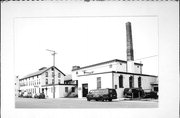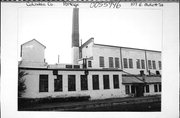Property Record
107 E MULLETT
Architecture and History Inventory
| Historic Name: | Portage Hosiery |
|---|---|
| Other Name: | Portage Woolen Mills, Inc. |
| Contributing: | Yes |
| Reference Number: | 55946 |
| Location (Address): | 107 E MULLETT |
|---|---|
| County: | Columbia |
| City: | Portage |
| Township/Village: | |
| Unincorporated Community: | |
| Town: | |
| Range: | |
| Direction: | |
| Section: | |
| Quarter Section: | |
| Quarter/Quarter Section: |
| Year Built: | 1903 |
|---|---|
| Additions: | |
| Survey Date: | 1992 |
| Historic Use: | mill |
| Architectural Style: | Astylistic Utilitarian Building |
| Structural System: | Brick |
| Wall Material: | Cream Brick |
| Architect: | |
| Other Buildings On Site: | |
| Demolished?: | No |
| Demolished Date: |
| National/State Register Listing Name: | Portage Industrial Waterfront Historic District |
|---|---|
| National Register Listing Date: | 3/17/1995 |
| State Register Listing Date: | 10/25/1994 |
| National Register Multiple Property Name: |
| Additional Information: | #650: Portgage Woolen Mills (48/1-19). Some third story windows closed; parapet and brick cornice with corbelling; segmental arch, steel windows. In 1903-1904, the factory building was extended to the eat by a three story, brick addition which was originally devoted to spinning (48/18). This building stands at the northwest end of the complex. Portage businessmen established two woolen mills one of which became one of the city's major industries. Robert B. Wentworth, W.S. Wentworth, and Loomis, Gallett, and Breese first promoted and organized the Portage Hosiery Company under a partnership in 1878. The company located in the Pettibone Block at the southwest corner of DeWitt and Cook until the 1880 fire. While the company moved to temporary quarters, construction of the mill began at 107 E. Mullett (48/19). The hosiery company occupied the 50 by 80 foot, two and a half story brick complex also included a separate engine room, a warehouse and office, and a dye house which no longer stand. Manufacturing its own yarns, the mill first produced heavy wool socks for lumbermen as well as leggings and mittens. The business partners incorporated the Portage Hosiery Company in 1893. R.B. Wentworth remained president of the company from its incorporation until Llewellyn Breese, who acted as its previous manager, replaced him in 1913. Succeeded by his son William L. Breese, Ll. Breese retired in 1931. By 1897, the company employed 110 workers. The Portage Hosiery Company also operated several branch factories. In 1910, it established one branch in Madison which operated at least into the 1930s. Opened at a unknown date, the Mauston branch probably closed in 1931. By 1933, the Portage plant employed 222 workers, double the number working in 1897. Despite previous attempts to organize a labor union, employees were not permitted to join the American Federation of Hosiery Workers until 1941 (Zunker 1951). The mill's physical plant gradually expanded in the 1890s and twentieth century as its volume of production steadily rose. The company added the office building (48/15) in 1891. In 1903-1904, the factory building was extended to the east by a three story, brick addition which was originally devoted to spinning (48/18). The current one story powerhouse (48/17) at the east end of the complex was completed about 1903. The company erected the warehouse in 19128 (48/13), and placed a wash house at the rear of the complex in 1924 (see 48/19). It stood east of the dye house constructed in 1903-04 and the concrete, steam dry house erected in ca. 1918 (see 48/19). In 1936, the company placed a new, two story and basement, 118 foot by 60 foot, tile building (48/14) between the office building and mill. A stair tower connected to the office building, and the wing provided a new entrance into the factory complex. Livermore and Samuelson served as the architects while C.H. Findorff of Madison became the contractor (Registere-Democrat 1936 [7/25: 1/4). The building housed the knitting machines. Finally, in 1952, the company added a two story and basement 40 by 83.7 foot addition (48/11) at the southwest end of the complex. The concrete block building with flat roof wsz opened by steel frame windows (Sanborn Perris Map Company 1885; 1889; 1894; 1901; 1918; 1929; Columbia County Treasurer 1863- [1890-1930]). |
|---|---|
| Bibliographic References: |
| Wisconsin Architecture and History Inventory, State Historic Preservation Office, Wisconsin Historical Society, Madison, Wisconsin |


